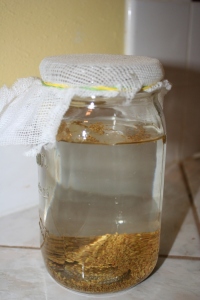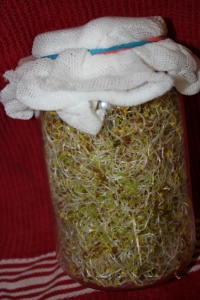Many times I have passed by the alfalfa sprouts at the store and thought to myself, “ I should just do that myself”.
So I never bought any but I never grew any sprouts at home either.
That is until now.
Who knew that is was so easy?
Sprouts are so incredibly good for you. The nutrients of grains, seeds, and legumes are increased many times when they are in their sprouted state. Sprouting is easy and is a good skill to learn should their come a day your supply of greens are limited. Some of you hoarders of wheat (like me) may be interested to know that you can sprout that stuff.
Another interesting thing to note about sprouts is that many of the proteins are broken down, which makes them easily absorbable by the body, even for those with weak digestive systems-should that be an issue.
There are Six Rules of Sprouting:
1. Rinse Often
2. Keep them moist, not wet,
3. Keep them at room temperature
4. Give them plenty of room to breathe
5. Don’t put too many in one container
6. Keep them covered (no light)
So far, I have only tried alfalfa sprouts but I will be expanding my repertoire and report on my endeavours here.
In the meantime, here is a step by step pictorial tutorial.
Try this at home.
Alfalfa Sprouts-high in protein, essential amino acids, and eight digestive enzymes; vitamins A, C, B complex, D, E, and 4 minerals; iron, phosphate, calcium, magnesium, and potassium.
Step one:
Put about 1 1/2 tablespoons of alfalfa seeds in a wide mouth mason jar.
Step 2:
Fill it up with water and place cheesecloth on top of the jar. Use rubberbands to hold the cheesecloth in place.
Let the seeds soak overnight on your counter top (about 8 hours).
Step 3:
The next morning, drain the water out of the jar.
Rinse the seeds with water and drain.
Tip the jar upside down and at a slight angle to allow the water to continue to drain out.
Loosely cover the jar with a dish towel. The point is to keep the light out but the air flowing.
Step4:
Rinse your seeds 2-3 times a day repeating the instructions in step 3.
Do this for about 3 or 4 days or until the sprouts are the length you desire.
Step 5:
After the final time rinsing and draining, divide the contents into two mason jars, replace the cheesecloth with mason jar lids, and place the sprouts in the refrigerator.
Use them within about 3-4 days.
You can eat them on salads or sandwiches or anything you like. You can even put some in your homemade bread recipe (add when you put in all the wet ingredients). My favorite way to eat alfalfa sprouts is in a pita with some chicken, lettuce, and parmesan cheese. Yummy!
5 Comments
-
It great to make sprout at home. We normally make moong beans sprout, the one use in Chinese cooking. I have to try different bean now. It sounds healthy. Thanks for sharing.
-
Tes, I’ve only known moong beans as “mung” beans. Nice to know the Hindi name. I was going to say that mung/moong bean are my favorite sprouted bean, very tasty. And sprouted wheat-also delicious unless you let the sprout get too long then it tastes like grass. (How do I know what grass tastes like?)
-
I’m not sure I like sprouts! Maybe I should try them again to see for sure.
-
Trying to do sprouts myself seems like a recipe for disaster. I can’t imagine ever being able to remember to do all these steps over the course of many days, because you know, I am forgetful. However, thanks for the info on the nutritional qualities of sprouts. I had no idea. And I do like sprouts so now I have greater impetus to buy and eat them. I liked the tip on putting them in bread too. Very smart.
-
Hi Jen, Just a comment that might simplify the process a tiny bit. If you don’t have cheesecloth lying around your house, an old, clean nylon stocking works for the top the same way. I love sprouts!




